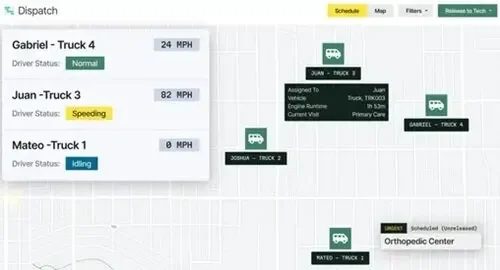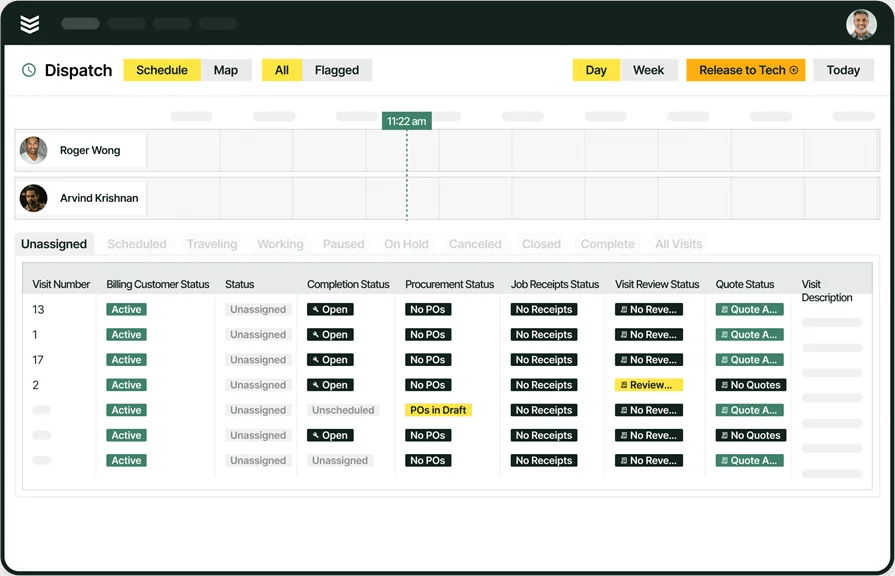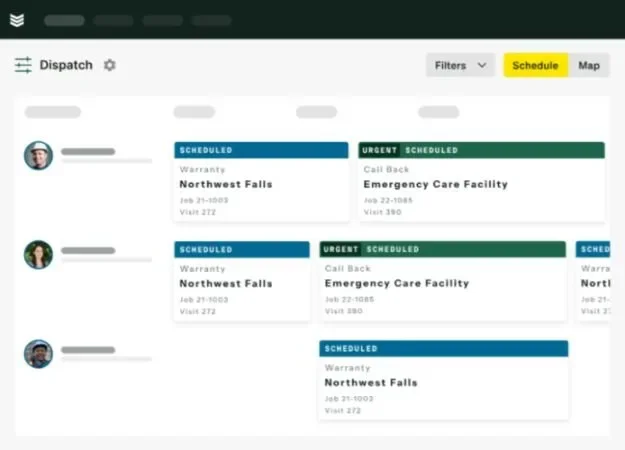When your crew’s jumping from site to site, the last thing you need is confusion over who’s going where and when. Missed jobs, double bookings, or last-minute scrambles? That stuff eats up time and kills momentum fast. A contractor scheduling app keeps the chaos in check. It helps you move faster, stay organized, and keep your jobs tight.
From solo operators to full crews, these apps do more than just fill in a calendar. They keep your team moving with real-time updates, smart dispatching, and tools that work where you do—on the job, not behind a desk. Whether you're booking installs, lining up service calls, or keeping tabs on multiple techs, scheduling software gives you that edge.
And if you’re looking to take things further—organizing crews, optimizing routes, managing field updates—this deeper guide on field service scheduling breaks it all down step by step. Here’s what we’re covering in this guide:
- Choosing the right contractor scheduling app for your team
- 6 key scheduling app features for contractors to look for
- Types of scheduling apps for contractors
- 6 best contractor scheduling apps for all types of teams
- 7 benefits of using a scheduling app for contractors
- 4 contractor scheduling app FAQs answered
Let’s kick off with what really matters—how to pick a scheduling app for contractors that works the way your crew does: fast, flexible, and straight to the point.
Choosing the right contractor scheduling app for your team
Scheduling is the backbone of every job. Get it right, and your day runs smooth. Get it wrong, and you’re playing catch-up before lunch. That’s why contractors pay close attention to the contractor scheduling app they put in play. It’s got to work in the field, not just look good in the office. Every minute counts, and you need a tool that helps the whole crew stay on task without slowing them down.
The best tools keep things moving—assignments go out fast, changes show up right away, and everyone stays in the loop without needing to make extra calls. If you’re weighing options, here’s what to keep in mind when picking a scheduling app for contractors:
- Ease of use on the job – Can your crew pull it up and get going without training? Is it quick to reschedule or reassign when plans shift? Can field techs handle it on their phone without checking in with the office?
- Works without service – Will the app still run when your team’s working underground, in a mechanical room, or at a remote site? Can they punch in, update notes, or complete tasks offline? Does it automatically sync everything once they’re reconnected?
- Real-time sync – When schedules change, does the update reach everyone fast? Can you send alerts or new instructions without calling each tech? Are updates clear enough that nothing slips through?
- Built for the trades – Can it handle how your jobs actually run—like recurring service, two-part visits, or assigning multiple techs to one project? Can you schedule based on technician certifications, location, or tools needed?
- Features – Does it come with extras like team tracking, job history, or dispatch tools? Can it connect with your CRM or reporting system? Will it give you data on job timing, tech efficiency, or unassigned calls?
A tool that’s clunky, slow, or out of sync with how your team works will just create more friction. The best scheduling app for contractors keeps the day moving and the crew locked in—job after job.
6 key scheduling app features for contractors to look for
The days of scribbling jobs on whiteboards or chasing updates by phone are done. Contractors now rely on tools that match the pace of the field. A contractor scheduling app has to do more than just display a calendar—it needs to handle the moving parts of daily operations with speed, clarity, and zero guesswork.
Whether you're managing a growing crew or handling solo service calls, the best scheduling app for contractors comes down to the features built into it. These are the ones that help you stay ahead of the schedule, not stuck reacting to it.
1. Smart scheduling and dispatch tools
When emergencies pop up or plans shift, your app should make rescheduling and dispatch simple—not chaotic. It should let you drag, drop, and reassign jobs without jumping between screens. Real-time scheduling, clear crew visibility, and instant updates keep everyone on track.
Let’s say a heavy rain throws off your morning roofing jobs. Using field service dispatch software, your office shifts priority jobs, reroutes teams, and notifies techs on their devices—all before anyone leaves the driveway.

Minimize jobs delays with BuildOps
Always assign the right tech to the job with BuildOps’ dispatching software.
2. Mobile-first access from the field
Crews can’t wait for signal or office help to move forward. A scheduling app for contractors should be fully mobile, giving techs job details, updates, and task tracking right from their phones—whether they’re online or not.
For example, a service tech working inside a metal-clad warehouse loses coverage. With a technician mobile app, they log completed work, add notes, and check their next stop—all offline. The app syncs everything once they’re back in range.
3. Real-time updates and status alerts
The job board isn’t static. Delays, cancellations, and urgent requests need to hit the field immediately. Real-time alerts keep crews in sync without radioing in or waiting on callbacks.
Let’s say a tech finishes early and is about to head to lunch. A notification from your fleet management system sends them a closer service call—cutting drive time and knocking out a job that would’ve otherwise waited until tomorrow.
4. Built-in quoting and work scope changes
Things change in the field—extra parts, added labor, or scope changes after the job starts. Your scheduling app should let techs adjust quotes and update work orders without having to call the office or start from scratch.
Say your plumbing tech opens a wall and finds a corroded valve that wasn’t on the original ticket. With contractor quoting software, they update the job, get quick sign-off from the customer, and keep things moving without delay.
5. Job history and CRM access
Being able to check service history, client details, and past issues saves time and prevents missteps. Look for a contractor scheduling app that connects to your CRM and puts all that info in the hands of your techs.
Imagine a tech returning to a commercial property where the client asks about an old breaker panel. With CRM access, they pull up exactly when it was serviced, what was done, and who signed off—on the spot.
6. Clear reporting and job visibility
You can’t fix what you can’t see. Reporting tools give you a live view of open jobs, delays, and trends in your workflow. They help you adjust schedules, balance workloads, and flag issues before they get expensive.
Let’s say overtime hours are piling up on your Friday shift. With job reporting software, you spot that one region is consistently behind—and find out it's due to too many stacked jobs on one tech’s route.
Other useful features for contractor scheduling apps
Beyond the core tools, some features take a contractor scheduling app from good to great. These aren’t mandatory to get the job done, but they can cut admin time, improve job tracking, and add flexibility to how your crew works in the field. When things are moving fast, these extras help you stay organized without adding friction.
- Service agreement management – For contractors who manage long-term clients or recurring maintenance, having a service agreement system built into your scheduling app can be a game-changer. It lets you pre-schedule recurring jobs, track upcoming service dates, and keep commitments from slipping through the cracks.
- Time tracking visibility – When techs are billing hourly or switching between jobs, tracking their time accurately matters. A time tracking feature inside your scheduling tool gives clear records for payroll, job costing, and productivity—without relying on manual logs or guesswork.
- Sales pipeline integration – Connecting scheduling with your sales process helps your team move faster from estimate to execution. With a sales pipeline tool, you can automatically trigger follow-ups, assign new jobs based on won opportunities, and see where future work is coming from.
Expert Tip
Want to take scheduling, dispatch, quoting, and job tracking off separate systems? Contractors using an all-in-one platform like the BuildOps field service management platform can run every part of the job—from first call to final invoice—in one place. No jumping between tools, just one system that keeps the whole crew in sync.
These extras won’t replace the essential tools—but when combined with the core features, they help contractors fine-tune their process and stay ahead of growing demands. Next up, let’s break down the types of scheduling apps contractors use, and which setup fits your workflow best.
Types of scheduling apps for contractors
Contractors run different types of jobs. Some focus on fast residential repairs, others juggle large-scale installs or long-term maintenance contracts. The contractor scheduling app that fits best depends on how your team operates in the field, what tools you're already using, and how tightly you need everything connected. These are the main types of scheduling apps to consider:
Standalone scheduling apps
These are basic tools that let you assign and manage jobs from a phone, tablet, or desktop. They’re common among solo contractors or smaller teams who just need a quick way to get jobs on the calendar. But keep in mind—they often don’t connect to dispatch, service history, or quoting, which means you might double-handle data across systems.
Best For: Solo general contractors, one-person HVAC or plumbing businesses, residential service techs
Basic calendar-based schedulers
Some contractors use calendar apps or simple scheduling plugins to assign jobs and block out time. Tools like Google Calendar or Excel sheets are quick to set up, but they lack real-time crew visibility, dispatch functionality, and job-specific tracking. These tools can work in a pinch—but they don’t scale well when your crew or job volume grows.
Best For: Small service teams, shops with low job volume, businesses just starting to digitize their operations
All-in-one contractor platforms
These tools connect scheduling with invoicing, dispatch, quoting, and customer history. Your team can clock in, get assigned, and close out the job—all in one place. If you’re scaling up or managing several field crews, this setup keeps jobs organized and crews moving without app switching.
Best For: HVAC, plumbing, fire protection, and mechanical contractors who dispatch multiple techs or run service-heavy workflows
Choosing the best type of scheduling app for contractors comes down to how you run things in the field. Next up, we’ll look at the top apps that help crews stay focused and get the job done right.
6 best contractor scheduling apps for all types of teams
Every contractor has their own rhythm—different team sizes, job types, and ways of getting work done in the field. That’s why the best scheduling app for contractors depends on how your business actually runs. Whether you’re scheduling high-volume service calls, coordinating multiple techs across job sites, or managing long-term install work, the tools below help keep jobs on track and crews synced up.
Here’s our take on the top scheduling apps delivering real results:
1. Best for commercial contractors: BuildOps
BuildOps was made for contractors managing high-volume jobs, multi-tech crews, and tight timelines. It gives field teams real-time job assignments, dispatch updates, and centralized scheduling—all from one connected system. You can assign jobs, reroute techs, and get instant status updates without ever leaving the dashboard.
App Type: Cloud-based platform
How Pricing Works: Custom pricing based on team size and tools required
Features Beyond Scheduling:
- Dispatching with GPS and tech availability
- Service history and customer data
- Workflow automation for recurring jobs
What Sets it Apart for Contractors: BuildOps links scheduling with dispatch, job history, quoting, and more—giving you one workflow to manage every moving piece in real time.

Improve your daily operations
Tighten up how you schedule, assign, and track jobs with BuildOps.
2. Best for residential contractors: Skedulo
Skedulo is built for home service teams that need to move fast. The platform includes mobile job scheduling, route optimization, and client appointment tracking in one simple interface. It’s designed to support quick scheduling decisions and clear field visibility. However, it may not be ideal for larger teams looking to manage complex dispatching or service histories across multiple departments.
App Type: Cloud-based solution
How Pricing Works: Tiered pricing depending on number of users and capabilities
Features Beyond Scheduling:
- Drag-and-drop calendar interface
- Mobile job assignments and alerts
- Optimized travel routing for techs
What Sets it Apart for Contractors: Skedulo’s focus on real-time field visibility makes it especially useful for residential jobs that need fast booking and clean coordination.
3. Best for general contractors: Jobber
Jobber helps general contractors organize jobs, assign crews, and manage schedules across multiple projects. With color-coded calendars, mobile access, and easy-to-use booking tools, it gives you control over both team workloads and job timelines. That said, it might feel limiting for larger commercial teams that need tighter integration with quoting, dispatch, or multi-day project phases.
App Type: Cloud-based field service platform
How Pricing Works: Monthly plans based on feature tiers and team size
Features Beyond Scheduling:
- Automated job reminders and confirmations
- Client management and estimate tracking
- Sync with QuickBooks and Stripe
What Sets it Apart for Contractors: Jobber keeps scheduling clean and visual, giving general contractors an easy way to keep jobs on time and avoid double-booking crews.
4. Best for small teams: Calendly
Calendly works well for small contractor teams handling fewer jobs and simple appointment scheduling. It’s best for booking service calls directly with clients, using customizable links and real-time availability. The platform makes it easy for homeowners or property managers to pick open time slots, reducing back-and-forth. Still, it’s not designed for field dispatch or multi-tech coordination—so it may fall short for growing teams or contractors juggling multiple job sites.
App Type: Cloud-based scheduling tool
How Pricing Works: Free basic version with premium tiers for integrations and custom features
Features Beyond Scheduling:
- Self-booking links for clients
- Calendar sync with Google and Outlook
- Simple reminders and confirmations
What Sets it Apart for Contractors: Calendly simplifies appointment booking, which is useful for solo contractors or admin-light operations that don’t need advanced field features.
5. Best for independent contractors: DriverSchedule
DriverSchedule caters to independent service contractors and franchise operators needing flexible job assignment tools. It blends scheduling with time tracking and basic workforce management, giving you oversight without being too complex. However, it may not be the best choice for contractors needing deep integrations with dispatch or quoting systems.
App Type: Web-based contractor scheduling and workforce platform
How Pricing Works: Custom pricing available for small teams and franchise models
Features Beyond Scheduling:
- Time clock and crew availability tracking
- Automated recurring job scheduling
- Resource allocation tools
What Sets it Apart for Contractors: DriverSchedule fits well for contractors managing individual service routes or local crews who need clarity on shifts, time, and task flow.
6. Best for specialty contractors: Service Fusion
Service Fusion is tailored for specialty contractors—like low-voltage, fire safety, or refrigeration—who need to manage recurring work, large equipment, or detailed service records. It includes drag-and-drop scheduling, dispatch tools, and field-ready apps to keep everyone aligned. It may feel overwhelming for smaller teams that don’t need advanced service workflows or who prefer simpler interfaces.
App Type: Cloud-based service management platform
How Pricing Works: Subscription tiers based on user count and features
Features Beyond Scheduling:
- Field service mobile access
- Job progress tracking and service history
- Voice, text, and email notifications
What Sets it Apart for Contractors: Service Fusion supports the layered workflows that specialty contractors deal with—giving visibility from service call to follow-up without losing detail.

Easily compare software options
Find the right for you with our easy-to-use scoresheet that lets you compare tools.
7 benefits of using a scheduling app for contractors
When you’re running jobs across different sites, managing techs with different skill sets, and juggling shifting timelines, a contractor scheduling app does more than just keep your calendar full. It gives your business control. The benefits show up in the field, at the office, and in the margins that separate barely getting by from finishing strong.
Here’s what a solid scheduling app for contractors helps unlock:
1. Faster response time
When jobs come in, you need to act fast. Scheduling tools help you assign jobs instantly and push them to your techs in seconds. That means fewer missed windows and more booked jobs in a day. For service businesses handling on-demand calls, tools like a field service booking system make it easier to stay ahead of the rush.
2. Fewer job site mix-ups
Clear assignments, updated locations, and time-stamped notes help prevent mistakes like techs showing up at the wrong address or bringing the wrong tools. With a field service ticketing system, every job gets logged with details that actually follow the tech—cutting down on confusion and callbacks.
3. More efficient dispatching
Instead of assigning jobs manually or guessing who’s free, scheduling apps let dispatchers make smart decisions based on tech availability, proximity, and workload. When paired with a contractor dispatch management system, the dispatch process becomes faster and more accurate, with fewer gaps or wasted trips.
4. Stronger visibility for managers
Field managers can’t be everywhere at once. Scheduling apps give them live updates on job status, team activity, and any issues in progress. Paired with field service dashboards, managers get a bird’s-eye view of what’s happening—and what’s falling behind—without needing a dozen phone calls.
5. Better use of your techs’ time
Instead of idle hours between calls or overloading the same crew every day, a contractor scheduling app helps distribute work evenly. That means less burnout and more jobs completed per tech. It also makes it easier to adjust when someone calls out or a job takes longer than expected.
6. Improved customer experience
Customers want to know when your crew is showing up and whether the job will get done right. Real-time updates, appointment confirmations, and consistent scheduling build trust. Scheduling apps make it easier to follow through—especially when your dispatching and scheduling tools are working together behind the scenes.
7. Cleaner workflows across the board
When scheduling is dialed in, everything else runs smoother—dispatch, invoicing, quoting, even service reporting. You’re not piecing together updates from multiple places or wondering what’s done and what’s overdue. That clarity gives your whole operation more stability, especially when scaling up.
4 contractor scheduling app FAQs answered
Contractors rely on tight schedules to keep jobs moving. Before switching to a new tool, most teams want to know how a contractor scheduling app handles real job conditions—field changes, signal loss, tech availability, and job detail management. These are the most common questions contractors ask before rolling one out to the crew.
1. What is a contractor scheduling app?
It’s software that lets contractors assign jobs, update schedules, and manage field crews without going through spreadsheets. The app connects the office and the field by showing who’s doing what, where, and when—on a desktop or a mobile device that has all the needs of their day-to-day operations.
2. How does a contractor scheduling app help in the field?
It keeps your techs moving without depending on office check-ins. When a tech opens the app, they see exactly where they’re going, who the contact is, what tools are needed, and any job notes. They don’t have to wait for paperwork or waste time chasing details. Updates—like cancellations, reassignments, or location changes—show up instantly, so they’re never working off outdated information. The result is fewer delays, less confusion, and more jobs closed out on time.
3. Do contractor scheduling apps work offline?
Yes. Most contractor-grade scheduling apps are designed to handle low-signal or no-signal conditions. If a tech is in a basement, mechanical room, or remote area with no reception, they can still see their job list, log updates, and record progress. Once they’re back in range, the app syncs everything automatically—no duplicate entry, no missed data. This keeps the day running even in areas where cell service drops off.
4. What are the best practices for using a contractor scheduling app?
Using the app properly is key to getting results. These practices help teams avoid gaps and stay on track:
- Schedule jobs ahead when possible
- Use alerts to flag schedule changes in real time
- Assign based on techs’ location, tools, and skills
- Keep job notes clear, with no missing details
- Include any site access instructions
- Require status updates on job progress
- Review the schedule daily to adjust for delays
- Reassign jobs immediately if someone calls out
Contractors don’t need more tools—they need better ones that actually support how their teams work in the field. A good contractor scheduling app keeps the wheels turning: assigning jobs fast, updating crews in real time, and making sure no one’s left guessing what’s next. Whether you're a small outfit managing a daily job list or a growing operation balancing dispatch, maintenance, and service calls, scheduling tools that work the way the field works are no longer optional—they're expected.
And if you’re juggling more than just schedules—like quoting, dispatch, customer info, or recurring jobs—platforms like BuildOps can bring all of it under one roof. It’s not just about making a calendar digital; it’s about connecting every moving part of the job so you can lead the day, not chase it.

Book more jobs with BuildOps
Built specifically for contractors, we fit how your crew actually works.








